Balbharti Maharashtra State Board Class 11 Geography Solutions
Chapter 7 Indian Ocean – Relief and Strategic Importance Textbook Exercise Questions and Answers.
1. Complete the chain.
Question 1.
Answer:

2. Give geographical reasons.
Question 1.
Salinity is less in the Bay of Bengal than in the Indian Ocean.
Answer:
Salinity is less in the Bay of Bengal than in the Indian Ocean because-
Question 2.
The eastern coastal part of the Indian Ocean is seismically active.
Answer:
The eastern coastal part of the Indian Ocean is seismically active because-
Question 3.
Gyre develops in Southern Indian Ocean.
Answer:
Gyre develops in Southern Indian Ocean because-
Question 4.
Temperatures are high in pre-monsoon season in the equatorial region in northern Indian Ocean.
Answer:

3. Write short notes on.
Question 1.
The width of continental shelf in the Bay of Bengal and the Arabian Sea
Answer:
The continental shelf in the Bay of Bengal is narrow but the continental shelf in the Arabian sea is very wide.
The river which bring sediments to the continental shelf of the Arabian Sea are short and swift. Therefore, the sediments in the river are deposited in the Continental shelf. The rivers which bring sediments to the continental shelf of the Bay of Bengal are long, sluggish and voluminous, therefore sediments are deposited in deltas and not in the continental shelf.
There are a greater number of estuaries along the coastline of Arabian sea. There are a greater number of deltas along the coastline of the Bay of Bengal.
Question 2.
Mineral resources in the Indian Ocean
Answer:
There are large reserves of hydrocarbons being tapped in the offshore areas of Saudi Arabia, Iran, India and Western Australia. About 40% of the world’s offshore oil production comes from the Indian Ocean.
The beach sands along the coastline of the Arabian Sea is very rich in valuable minerals like uranium, thorium, radium, etc. Beach sands, rich in heavy minerals and offshore deposits are activity exploited by bordering countries particularly India, South Africa, Indonesia and Sri Lanka.
The Abyssal plains of Indian ocean have deposits of polymetallic nodules. These nodules are the source of nickel, copper, manganese and cobalt.
Question 3.
Ocean Currents in the Indian Ocean.
Answer:

Question 4.
Oil and natural gas in the Indian Ocean
Answer:
4. Answer in detail.
Question 1.
Outline the importance of the Indian Ocean with respect to trade and transport routes.
Answer:
Question 2.
Evaluate the strategic location of India with respect to its location in the Indian Ocean.
Answer:

Question 3.
Explain the Indian ocean with respect to following aspects:
(a) Ocean Trenches
(b) Abyssal Plains
(c) ridges
(d) Ocean Currents
Answer:
(a) Ocean Trenches
(b) Abyssal Plains:
(c) Ridges:
(d) Ocean Currents:
5. On an outline map of the world, locate the following and make an index:
1. Sunda Trench
2. Diego Garcia
3. SW Monsoon
4. Agulhas Current
5. West Australian Current
6. Ninety East ridge
7. Strait of Holmuz
8. Chabahar port
Answer:
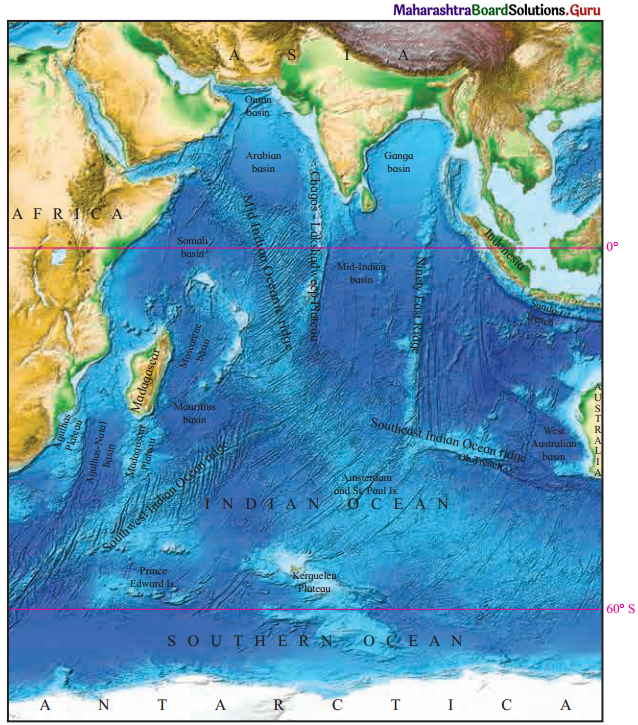

11th Geography Digest Chapter 7 Indian Ocean – Relief and Strategic Importance Intext Questions and Answers
Make friends with maps! (Textbook Page No. 75)
Look at the figure 7.1 and answer the following questions.
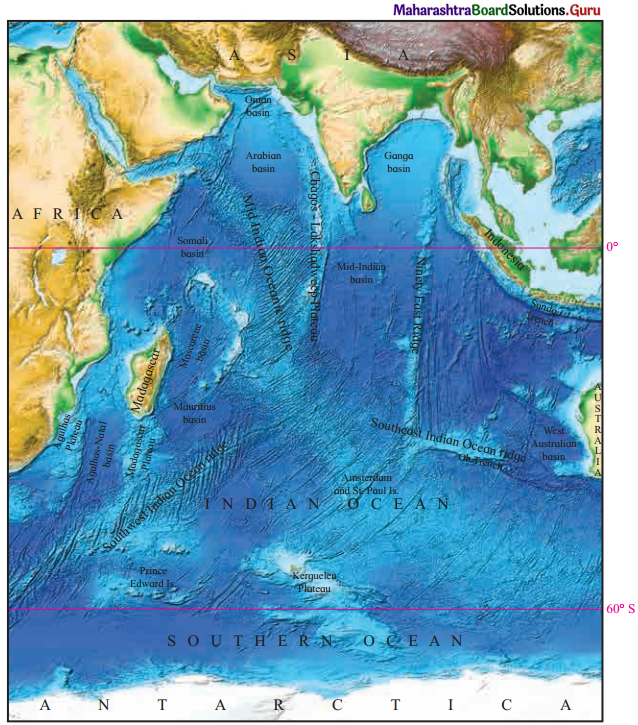
Question 1.
What does this map show?
Answer:
This map shows the relief of the Indian Ocean floor.
Question 2.
Which continents and sub-continents are visible in this map?
Answer:
The continents of Africa, Antarctica, Australia and the Indian sub-continent are visible in the map.
Question 3.
What lies between the continents?
Answer:
The Indian Ocean and the Southern Ocean lie between the continents.

Question 4.
Chagos Plateau, Sunda Trench, Central Mountain range are a part of what?
Answer:
The Chagos plateau is a part of Lakshadweep Plateau.
The Sunda Trench is a part of the Java Trench located in the Indian Ocean near Sumatra, formed where Australian – Capricorn Plates subduct under a part of the Eurasian Plate. The central Mountain Range is a part of Mid Indian Oceanic ridge.
Question 5.
What are the conclusions you can draw after looking at the map?
Answer:
Find Out! (Textbook Page No. 77)
Why Ninety East ridge name has been given to this ridge?
Answer:

Try This. (Textbook Page No. 78)
Given below are names of some ocean basins in the Indian Ocean. Identify these in figure 7.1. Write a note on their locations, their separators and the rivers entering into them. Rank these according to their size on the basis of your perception.
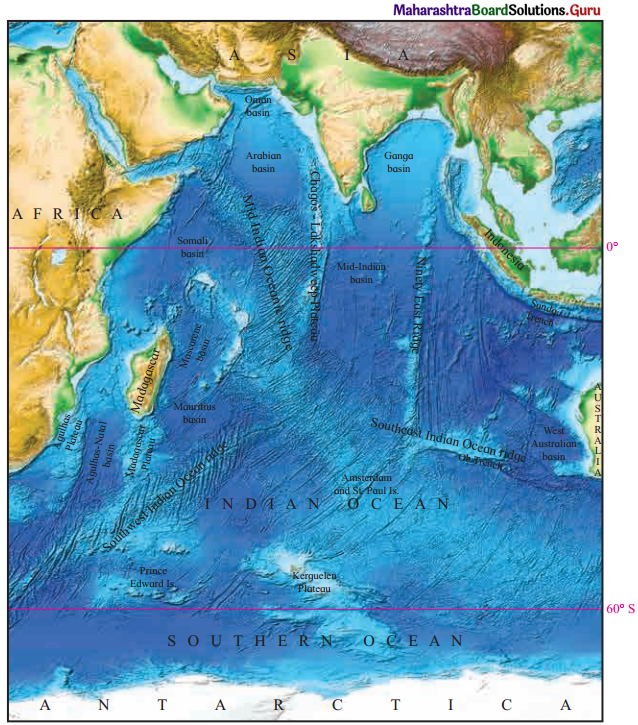
(1) Oman basin (2) Arabian basin (3) Somali basin (4) Mauritius basin (5) Mascarene basin (6) Agulhas-Natal basin (7) West Australian basin (8) Mid-Indian basin (9) Ganga basin
Answer:
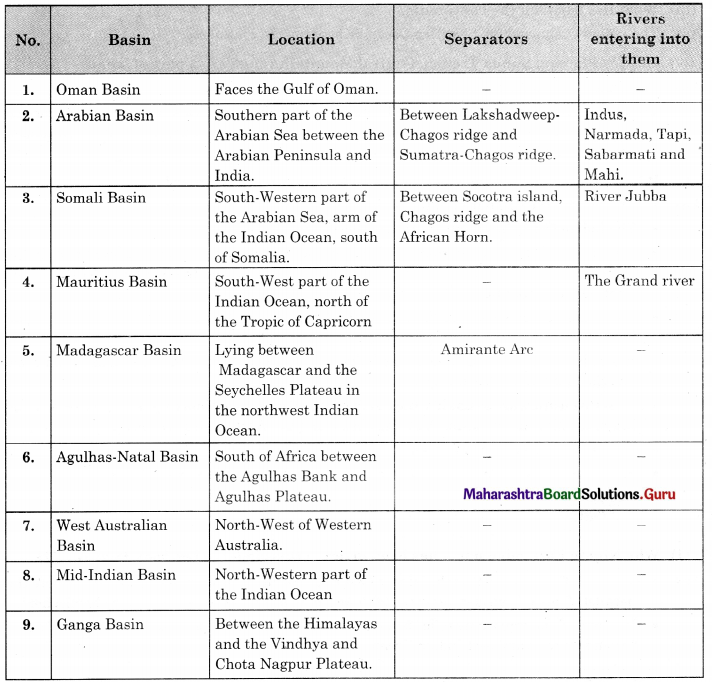
Can you do it?
1. Study maps given in the figure 7.2 carefully. These maps are showing the portion of Indian Ocean lying north of equator. Maps in the figure depict the temperature conditions in three seasons: (a) pre-SW monsoon (b) NE monsoon (c) during SW monsoon. Answer the following questions. (Textbook Page No. 78)
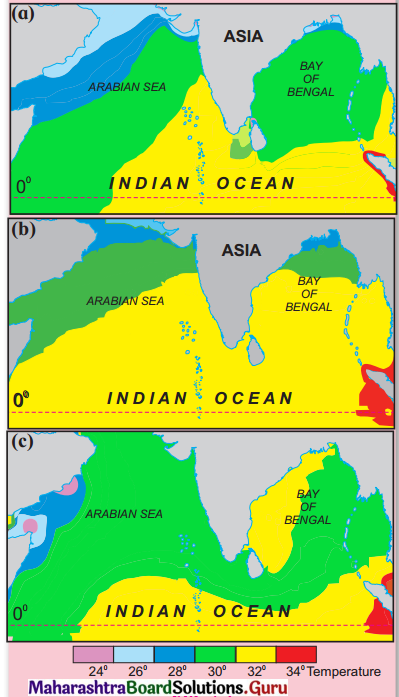
Question 1.
Why are isotherms not drawn on the continental part?
Answer:
The isotherms are not drawn on the continental part because there is summer season and the temperature is high almost everywhere. Since there is no variation in temperature, isotherms are not drawn.

Question 2.
Why is the temperature low in Arabian Sea than in Bay of Bengal?
Answer:
The temperature is low in Arabian Sea than in Bay of Bengal due to following reasons-
Question 3.
Why is the temperature higher in southern portion of Indian Ocean during pre-SW monsoon?
Answer:
The southern portion of the Indian Ocean is closer to the equator compared to the northern portion of the Arabian Sea. During pre-SW monsoon period, Uttarayan is observed therefore the temperature is high.
2. The given maps are depicting the salinity distribution of northern Indian Ocean. Study the maps (a) NE monsoon (b) pre-SW monsoon (c) SW monsoon given in the figure 7.3 carefully and answer the following questions. (Textbook Page No. 79)
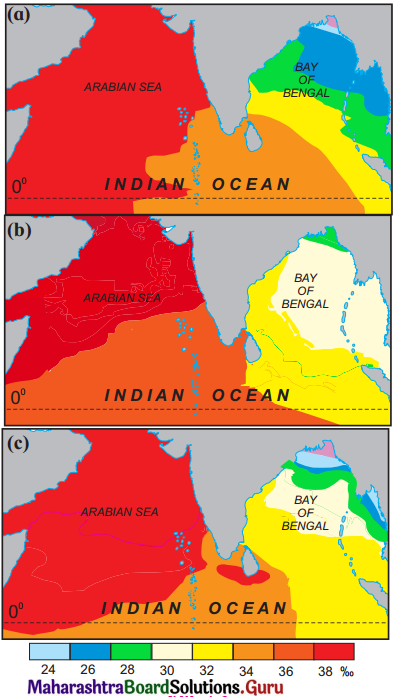
Question 1.
Why does the Arabian Sea record higher salinity than the Bay of Bengal?
Answer:
This leads to higher salinity in the Arabian Sea as compared to the salinity of the Bay of Bengal.

Question 2.
What is the minimum salinity in the Bay of Bengal? In Which seasons do we find it?
Answer:
The minimum salinity in the Bay of Bengal is 30 PSU (Practical Salinity Unit). This occurs in the late autumn and early winter months (November to January) when the East India Coastal Current flows southwards carrying low salinity water.
Question 3.
Account for the high salinity in the Arabian Sea throughout the year?
Answer:
This leads to higher salinity in the Arabian Sea as compared to the salinity of the Bay of Bengal.
Do you know? (Textbook Page No. 80)
See the maps in figure 7.4 A and B. They show the pattern of ocean currents in the Indian Ocean during different seasons. Study the maps carefully and answer the following questions.
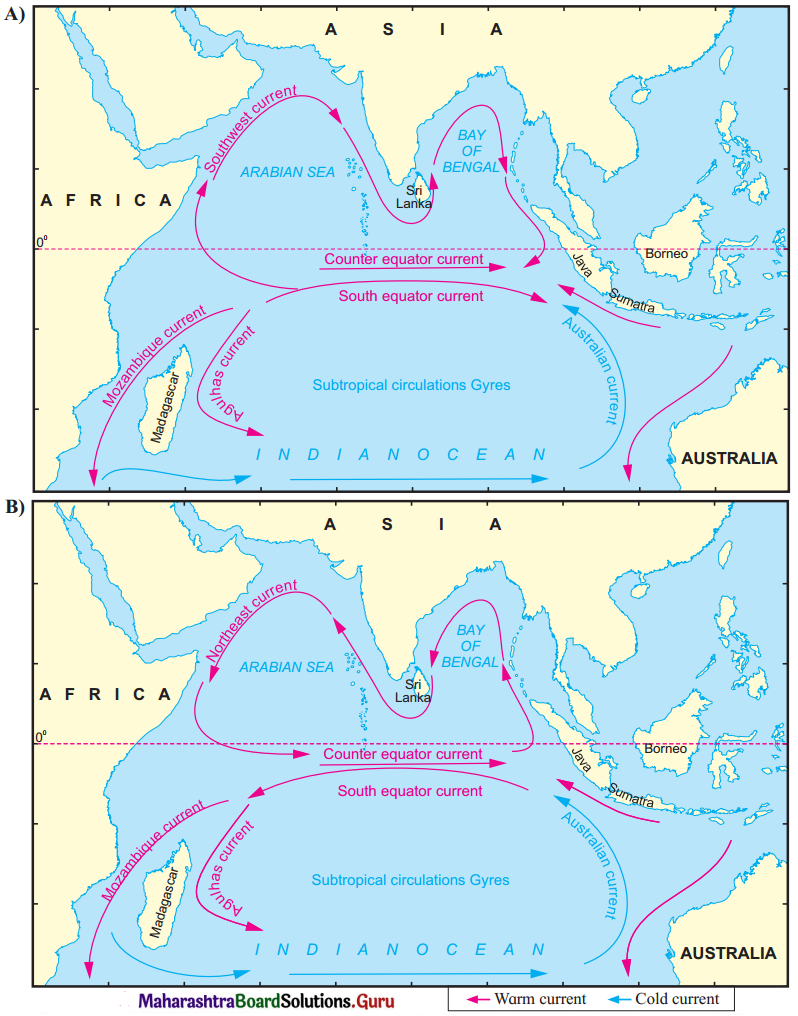
Question 1.
Identify the season each map is representing and name them accordingly.
Answer:
Question 2.
What difference do you notice in the direction of currents between winter and summer in Northern Part of the Indian Ocean?
Answer:
In the Northern Part of the Indian Ocean, during summer, the ocean currents flow along the coastlines and flow in the clockwise direction. In the winter season, these ocean currents flow a complete reverse and they flow in anticlockwise directions.

Question 3.
How many cold currents are there in the Indian Ocean? Name them.
Answer:
There are four cold currents in the Indian Ocean. The cold currents in the Indian Ocean are the North-East Monsoon Current, Somali Current, West Australian Current and South Indian Ocean Current.
Question 4.
Why do you think the cold currents are fewer in Indian Ocean?
Answer:
Question 5.
Which currents maintain the direction in both the seasons?
Answer:
The Mozambique Current, The Equatorial Counter Current, the Agulhas Current and the Australian Current maintain the direction in both the seasons.
Question 6.
Can you see any circulation in the currents of the Indian Ocean? What are such circulations called? If yes, name the currents sequentially.
Answer:
Yes, such circulations are currents called gyre.

Can you tell? (Textbook Page No. 81)
(i) Name the Gulf countries
(ii) In which direction do they lie in the Asian continent?
Answer:
(i) The Gulf countries are Kuwait, Oman, Saudi Arabia, UAE, Qatar and Bahrain. They are called as Gulf countries because they are members of the GCC (Gulf Co-operation Council).
(ii) They lie in the western direction in the Asian continent.
Chapter 7 Indian Ocean – Relief and Strategic Importance Textbook Exercise Questions and Answers.
1. Complete the chain.
Question 1.
| A | B | C |
| (1) Pacific Ocean | (1) Christmas | (1) Bab-al-Mandeb |
| (2) Chagos | (2) Atlantic Ocean | (2) Lakshadweep |
| (3) Ashmore | (3) Maldives | (3) Indian Ocean |
| (4) Hormuz | (4) Malacca | (4) Cocos |
| A | B | C |
| (1) Pacific Ocean | (1) Atlantic Ocean | (1) Indian Ocean |
| (2) Chagos | (2) Christmas | (2) Lakshadweep |
| (3) Ashmore | (3) Maldives | (3) Cocos |
| (4) Hormuz | (4) Malacca | (4) Bab-al-Mandeb |

2. Give geographical reasons.
Question 1.
Salinity is less in the Bay of Bengal than in the Indian Ocean.
Answer:
Salinity is less in the Bay of Bengal than in the Indian Ocean because-
Question 2.
The eastern coastal part of the Indian Ocean is seismically active.
Answer:
The eastern coastal part of the Indian Ocean is seismically active because-
Question 3.
Gyre develops in Southern Indian Ocean.
Answer:
Gyre develops in Southern Indian Ocean because-
Question 4.
Temperatures are high in pre-monsoon season in the equatorial region in northern Indian Ocean.
Answer:

3. Write short notes on.
Question 1.
The width of continental shelf in the Bay of Bengal and the Arabian Sea
Answer:
The continental shelf in the Bay of Bengal is narrow but the continental shelf in the Arabian sea is very wide.
The river which bring sediments to the continental shelf of the Arabian Sea are short and swift. Therefore, the sediments in the river are deposited in the Continental shelf. The rivers which bring sediments to the continental shelf of the Bay of Bengal are long, sluggish and voluminous, therefore sediments are deposited in deltas and not in the continental shelf.
There are a greater number of estuaries along the coastline of Arabian sea. There are a greater number of deltas along the coastline of the Bay of Bengal.
Question 2.
Mineral resources in the Indian Ocean
Answer:
There are large reserves of hydrocarbons being tapped in the offshore areas of Saudi Arabia, Iran, India and Western Australia. About 40% of the world’s offshore oil production comes from the Indian Ocean.
The beach sands along the coastline of the Arabian Sea is very rich in valuable minerals like uranium, thorium, radium, etc. Beach sands, rich in heavy minerals and offshore deposits are activity exploited by bordering countries particularly India, South Africa, Indonesia and Sri Lanka.
The Abyssal plains of Indian ocean have deposits of polymetallic nodules. These nodules are the source of nickel, copper, manganese and cobalt.
Question 3.
Ocean Currents in the Indian Ocean.
Answer:

Question 4.
Oil and natural gas in the Indian Ocean
Answer:
4. Answer in detail.
Question 1.
Outline the importance of the Indian Ocean with respect to trade and transport routes.
Answer:
Question 2.
Evaluate the strategic location of India with respect to its location in the Indian Ocean.
Answer:

Question 3.
Explain the Indian ocean with respect to following aspects:
(a) Ocean Trenches
(b) Abyssal Plains
(c) ridges
(d) Ocean Currents
Answer:
(a) Ocean Trenches
(b) Abyssal Plains:
(c) Ridges:
(d) Ocean Currents:
5. On an outline map of the world, locate the following and make an index:
1. Sunda Trench
2. Diego Garcia
3. SW Monsoon
4. Agulhas Current
5. West Australian Current
6. Ninety East ridge
7. Strait of Holmuz
8. Chabahar port
Answer:


11th Geography Digest Chapter 7 Indian Ocean – Relief and Strategic Importance Intext Questions and Answers
Make friends with maps! (Textbook Page No. 75)
Look at the figure 7.1 and answer the following questions.

Question 1.
What does this map show?
Answer:
This map shows the relief of the Indian Ocean floor.
Question 2.
Which continents and sub-continents are visible in this map?
Answer:
The continents of Africa, Antarctica, Australia and the Indian sub-continent are visible in the map.
Question 3.
What lies between the continents?
Answer:
The Indian Ocean and the Southern Ocean lie between the continents.

Question 4.
Chagos Plateau, Sunda Trench, Central Mountain range are a part of what?
Answer:
The Chagos plateau is a part of Lakshadweep Plateau.
The Sunda Trench is a part of the Java Trench located in the Indian Ocean near Sumatra, formed where Australian – Capricorn Plates subduct under a part of the Eurasian Plate. The central Mountain Range is a part of Mid Indian Oceanic ridge.
Question 5.
What are the conclusions you can draw after looking at the map?
Answer:
Find Out! (Textbook Page No. 77)
Why Ninety East ridge name has been given to this ridge?
Answer:

Try This. (Textbook Page No. 78)
Given below are names of some ocean basins in the Indian Ocean. Identify these in figure 7.1. Write a note on their locations, their separators and the rivers entering into them. Rank these according to their size on the basis of your perception.

(1) Oman basin (2) Arabian basin (3) Somali basin (4) Mauritius basin (5) Mascarene basin (6) Agulhas-Natal basin (7) West Australian basin (8) Mid-Indian basin (9) Ganga basin
Answer:

Can you do it?
1. Study maps given in the figure 7.2 carefully. These maps are showing the portion of Indian Ocean lying north of equator. Maps in the figure depict the temperature conditions in three seasons: (a) pre-SW monsoon (b) NE monsoon (c) during SW monsoon. Answer the following questions. (Textbook Page No. 78)

Question 1.
Why are isotherms not drawn on the continental part?
Answer:
The isotherms are not drawn on the continental part because there is summer season and the temperature is high almost everywhere. Since there is no variation in temperature, isotherms are not drawn.

Question 2.
Why is the temperature low in Arabian Sea than in Bay of Bengal?
Answer:
The temperature is low in Arabian Sea than in Bay of Bengal due to following reasons-
Question 3.
Why is the temperature higher in southern portion of Indian Ocean during pre-SW monsoon?
Answer:
The southern portion of the Indian Ocean is closer to the equator compared to the northern portion of the Arabian Sea. During pre-SW monsoon period, Uttarayan is observed therefore the temperature is high.
2. The given maps are depicting the salinity distribution of northern Indian Ocean. Study the maps (a) NE monsoon (b) pre-SW monsoon (c) SW monsoon given in the figure 7.3 carefully and answer the following questions. (Textbook Page No. 79)

Question 1.
Why does the Arabian Sea record higher salinity than the Bay of Bengal?
Answer:
This leads to higher salinity in the Arabian Sea as compared to the salinity of the Bay of Bengal.

Question 2.
What is the minimum salinity in the Bay of Bengal? In Which seasons do we find it?
Answer:
The minimum salinity in the Bay of Bengal is 30 PSU (Practical Salinity Unit). This occurs in the late autumn and early winter months (November to January) when the East India Coastal Current flows southwards carrying low salinity water.
Question 3.
Account for the high salinity in the Arabian Sea throughout the year?
Answer:
This leads to higher salinity in the Arabian Sea as compared to the salinity of the Bay of Bengal.
Do you know? (Textbook Page No. 80)
See the maps in figure 7.4 A and B. They show the pattern of ocean currents in the Indian Ocean during different seasons. Study the maps carefully and answer the following questions.

Question 1.
Identify the season each map is representing and name them accordingly.
Answer:
Question 2.
What difference do you notice in the direction of currents between winter and summer in Northern Part of the Indian Ocean?
Answer:
In the Northern Part of the Indian Ocean, during summer, the ocean currents flow along the coastlines and flow in the clockwise direction. In the winter season, these ocean currents flow a complete reverse and they flow in anticlockwise directions.

Question 3.
How many cold currents are there in the Indian Ocean? Name them.
Answer:
There are four cold currents in the Indian Ocean. The cold currents in the Indian Ocean are the North-East Monsoon Current, Somali Current, West Australian Current and South Indian Ocean Current.
Question 4.
Why do you think the cold currents are fewer in Indian Ocean?
Answer:
Question 5.
Which currents maintain the direction in both the seasons?
Answer:
The Mozambique Current, The Equatorial Counter Current, the Agulhas Current and the Australian Current maintain the direction in both the seasons.
Question 6.
Can you see any circulation in the currents of the Indian Ocean? What are such circulations called? If yes, name the currents sequentially.
Answer:
Yes, such circulations are currents called gyre.

Can you tell? (Textbook Page No. 81)
(i) Name the Gulf countries
(ii) In which direction do they lie in the Asian continent?
Answer:
(i) The Gulf countries are Kuwait, Oman, Saudi Arabia, UAE, Qatar and Bahrain. They are called as Gulf countries because they are members of the GCC (Gulf Co-operation Council).
(ii) They lie in the western direction in the Asian continent.